One of the crucial aspects of being a successful fantasy football player is to possess a working knowledge of how teams operate — what their tendencies are, which formations they prefer and how often a team may be leading or trailing. These trends can help us determine how players are valued and how they might be utilized by their respective teams.
Subscribe to PFF's EDGE or ELITE subscriptions to get access to the following tools, charts, etc.
– All Premium Article Content
– Fantasy Football Rankings & Projections
– Fantasy Football Draft Guide, Cheat Sheets & Advanced Stats
– Fantasy Football Mock Draft Tool (DraftMaster)
– Fantasy Football Strength of Schedule Matrix
– NFL Player Grades
– NFL Premium Stats
We also need to look back on individual performances to consider whether players with new roles or opportunities might offer more potential than some expect. Things are always changing in the NFL, and it's important to stay ahead of the pack.
What follows are three fantasy football stats to know for all 32 NFL teams heading into 2020.
ARIZONA CARDINALS
- According to PFF’s strength of schedule (SoS) metric, the Cardinals’ quarterback, running back and tight end schedules all rank as the fourth-easiest in 2020.
- The Arizona running back group ranked second in rushing yards before contact (916). This statistic bodes well for the team's ground game, in particular Kenyan Drake.
- Wide receiver DeAndre Hopkins has ranked as a top-five receiver in four out of the past five seasons, the only outlier being a down year in 2016. Head coach Kliff Kingsbury’s offense ranked first in the league in screen pass attempts (120) and in screen pass attempt percentage (21.7%) last season. Expect Hopkins — and other Arizona WRs — to see a boatload of cheap fantasy points (in full-point PPR leagues) by way of screen passes. Another top-five finish for Hopkins is very likely.
ATLANTA FALCONS
- No team attempted more passes than the Falcons in 2019 (684). While it’s fair to expect some regression toward a more well-balanced offense in 2020, the first-placed figure still holds some significant weight and should certainly be considered when evaluating the Falcons’ pass-game personnel.
- Former tight end Austin Hooper’s 93 targets (in 13 games) ranked sixth among all tight ends in 2019. With Hooper out and Hayden Hurst taking over the starting job, it’s fair to expect a significant workload for the former first-round draft pick. Hurst showed some promise in 2019, ranking 11th in yards per route run (1.69) among all tight ends with 25-plus targets.
- The Falcons’ offense ranked fifth in explosive plays passing (108 passes of 15-plus yards downfield). It doesn’t take a genius to know this number is significant for a dominant player like Julio Jones, but it should also factor in the expected breakout of running mate Calvin Ridley.
BALTIMORE RAVENS
- The Ravens’ rushing attack was unstoppable in 2019 — the Ravens led the NFL in the following categories: rushing attempts (596), rushing yards (3,296), rushing yards before contact (1,390), rushing yards after contact (1,810), rushing yards before contact per attempt (2.3), run play percentage (52%) and explosive run percentage (17.5%). They probably don’t need any help moving forward, but the schedule-makers decided to hand them some anyway — PFF’s SoS metric ranks their quarterback and running back schedules as the third-easiest and sixth-easiest in the league, respectively.
- Tight end Mark Andrews was dominant last season — he ranked third in total points (209.2), first in points per snap (0.46) and fourth in points per touch (3.27) among all tight ends (excluding Week 17). He doesn’t need it, but Hurst’s departure opens 36 extra targets, and PFF’s SoS metric ranks the team's tight end schedule as the fifth-easiest in 2020.
- If we exclude the games Marquise Brown missed (Weeks 6 and 7), the rookie wideout ranked inside the top five in receiving yards and receiving touchdowns among rookie receivers on 20-plus yard passes downfield. Brown dealt with a foot injury the entirety of his rookie season, and it noticeably hampered him. Brown now enters his second season fully healthy and should soon prove himself to be one of the top deep threats in the league.
BUFFALO BILLS
- No player in the NFL had more deep receiving yards (20-plus yards downfield) than recent acquisition Stefon Diggs. Diggs also led the league with six touchdowns on throws that deep. Josh Allen’s 30.9% adjusted completion percentage on such throws ranked 28th among all quarterbacks with 25-plus attempts. Expect some big plays between the two, but it’s also fair to expect a few soul-crushing misses.
- Allen’s legs went a long way to helping him become not only a viable starting quarterback option, but one of the most productive quarterbacks in the league — he ranked sixth in quarterback scoring (299.6) and sixth in points per dropback (0.55). Allen ranked third in rushing yards, first in rushing touchdowns, fifth in missed tackles forced per attempt and first in yards after contact per attempt among all quarterbacks with 25-plus rushing attempts.
- Tight end Dawson Knox ranked 32nd in tight end scoring in 2019 with 79.7 points, but there's reason to believe he'll be far more productive in 2020. Knox’s 10.1 average depth of target (aDOT) ranked seventh and his 13.9 yards per reception ranked third among all tight ends with 25-plus targets. In addition to his awesome display of efficiency, Knox’s schedule is ranked as the seventh-easiest in 2020, according to PFF’s SoS metric.
CAROLINA PANTHERS
- Teddy Bridgewater will be a welcome addition to the entire Carolina wide receiver corps. Last season, three Panthers WRs ranked in the top 12 of most incomplete targets attributed to the quarterback: Robby Anderson (third with 25), D.J. Moore (eighth with 20) and Curtis Samuel (12th with 19). Bridgewater ranked third in adjusted completion percentage (80.6%) among all quarterbacks with 100-plus attempts. Carolina's wide receivers will also see the NFL's fourth-easiest schedule according to PFF’s SoS metric.
- Former tight end Greg Olsen’s 81 targets ranked ninth among all tight ends in 2019. His departure opens up a massive opportunity for Ian Thomas.
- Dating back to 2013, head coach Matt Rhule’s offenses have deployed a 55.3% pass play percentage and a 44.7% run play percentage split.
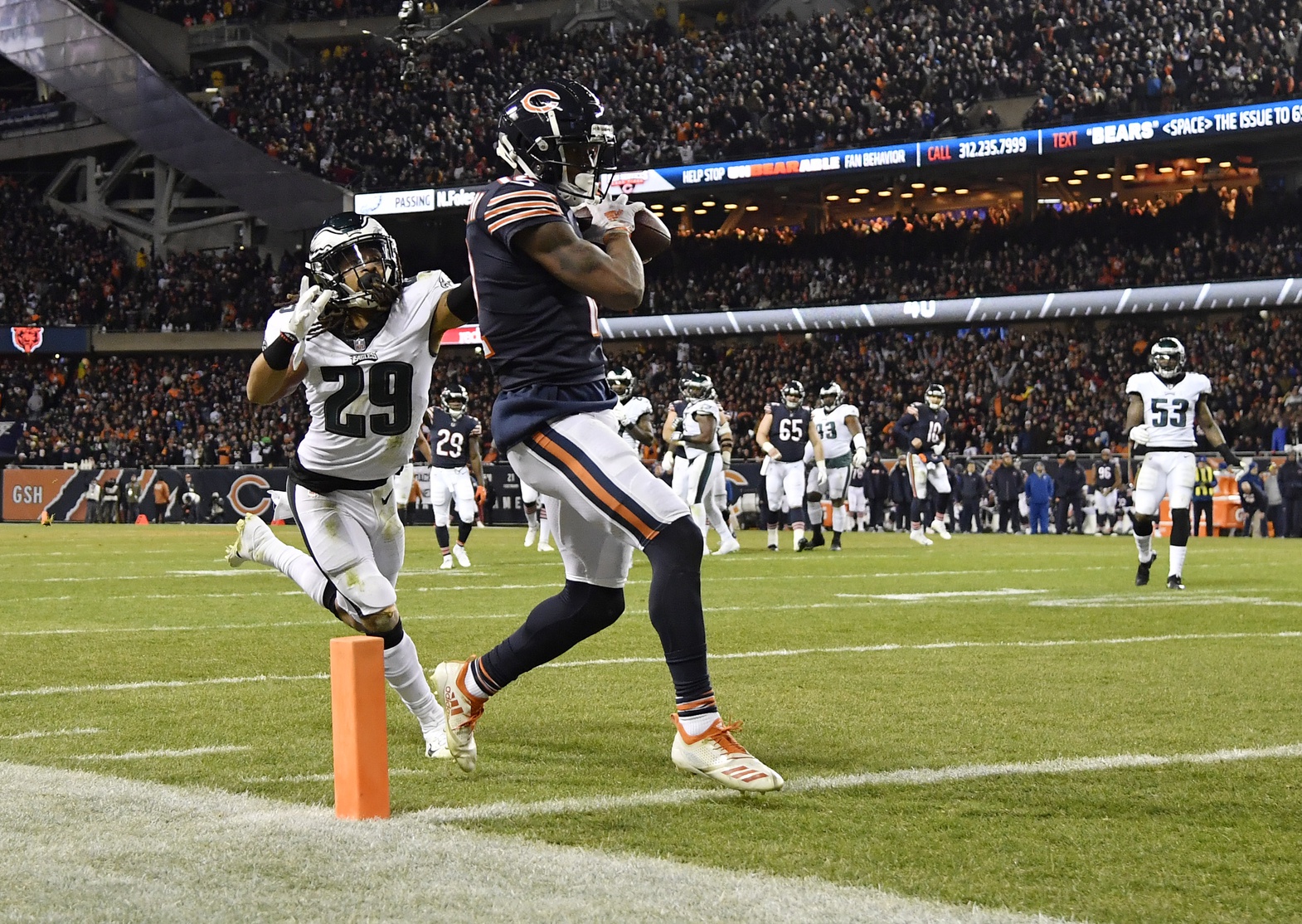
CHICAGO BEARS
- The Bears may not have a household name at their third receiver spot, but they do have a pass-catching back who operates as such — Tarik Cohen’s 102 targets ranked third and his 79 receptions ranked fourth among all running backs last season.
- Quarterbacks Nick Foles (27th) and Mitchell Trubisky (28th) did not rank well in their overall PFF grades. This situation has the potential to be disastrous.
- The Bears' backfield ranked 32nd in rushing yards after contact per attempt (2.3). The team simply needs better production out of David Montgomery and Cohen.
CINCINNATI BENGALS
- John Ross last season began to show flashes of what made him such a high draft selection — he ranked inside the top seven in yards per reception (18.07) and receiving yards after the catch per reception (7.21) last season.
- Joe Burrow’s final collegiate season will go down in the record books. The first-overall pick ranked second in passing yards and passing touchdowns, along with first in completion percentage and adjusted completion percentage. These marks bode well for the entirety of the Bengals’ receiving corps.
- Joe Mixon‘s 16 rushing attempts inside the opponents’ 4-yard line were the second-most in the NFL last season, but he scored only four touchdowns on them — which was 18th in the league. Expect some positive regression in Mixon’s touchdown numbers.
CLEVELAND BROWNS
- New head coach Kevin Stefanski ran the third-most snaps (254) in two-back sets in 2019 with the Minnesota Vikings. While their ceilings may be somewhat capped, both Nick Chubb and Kareem Hunt can co-exist, and both can be highly productive.
- Jarvis Landry has quietly become one of the more underappreciated players in fantasy football. Landry managed a WR12 finish (full-point PPR leagues) last season, even with his eighth-ranked inaccurate targets due to quarterback play (20 targets) figure. Here are Landry’s finishes dating back to 2015: WR12, WR19, WR4, WR13 and WR10.
- Baker Mayfield struggled to replicate his rookie season success, as he finished the season ranked as the QB19 (252.2 points). One of the major positives moving forward is the Browns’ seventh-ranked deep pass attempt percentage (14.3%). While Mayfield proved inaccurate on 20-plus yard passes last season (fifth-most inaccurate attempts on such passes), he has the ability to improve with increased volume and another year of chemistry with Odell Beckham Jr.
DALLAS COWBOYS
- The Cowboys ranked third in explosive plays passing (15-plus yards downfield) in 2019. The addition of wide receiver CeeDee Lamb and the promotion of tight end Blake Jarwin are likely to help increase those numbers even further.
- Although he may never become a full-time featured back with the presence of Ezekiel Elliott, Tony Pollard showed some serious promise in his rookie season, ranking seventh in missed tackles forced per attempt (0.27) and second in rushing yards after contact per attempt (4.5) among all running backs with 25-plus attempts.
- Dak Prescott ranked second among quarterbacks in points last season with 350.7. The offensive additions, plus new head coach Mike McCarthy and the fact that he's playing in a contract year, could lead to an even bigger season in 2020. The potential for an MVP trophy is legitimate.
DENVER BRONCOS
- The Broncos ranked 28th in explosive pass percentage (11.6%) after rookie Drew Lock took the reins at quarterback (Weeks 13-17). The additions of K.J. Hamler and Jerry Jeudy, along with the improved health of Noah Fant, should help increase that number.
- The offensive line ranked seventh in rushing yards before contact per attempt (1.4), but the running back group could not recreate the same magic with rushing yards after contact, as they ranked 27th per attempt (2.5).
- Two years ago, UDFA running back Phillip Lindsay scored the second-most fantasy points in a rookie season among all undrafted free agents, with a total of 222.8 points.
DETROIT LIONS
- Matthew Stafford only lasted eight weeks into the 2019 season, but he was highly productive, ranking ninth in total points and seventh in points per dropback among quarterbacks.
- During the eight weeks with a healthy Stafford, no team threw more deep pass attempts (48) or had a higher deep pass attempt percentage (19.2%) than the Lions. They truly developed into a downfield passing attack.
- Over that same eight-week timeframe, both Kenny Golladay (first) and Marvin Jones Jr. (sixth) ranked near the top of the league in receiving touchdowns. The trio of Stafford, Golladay and Jones were truly fantastic and could offer a potential three-way stack in 2020 leagues.
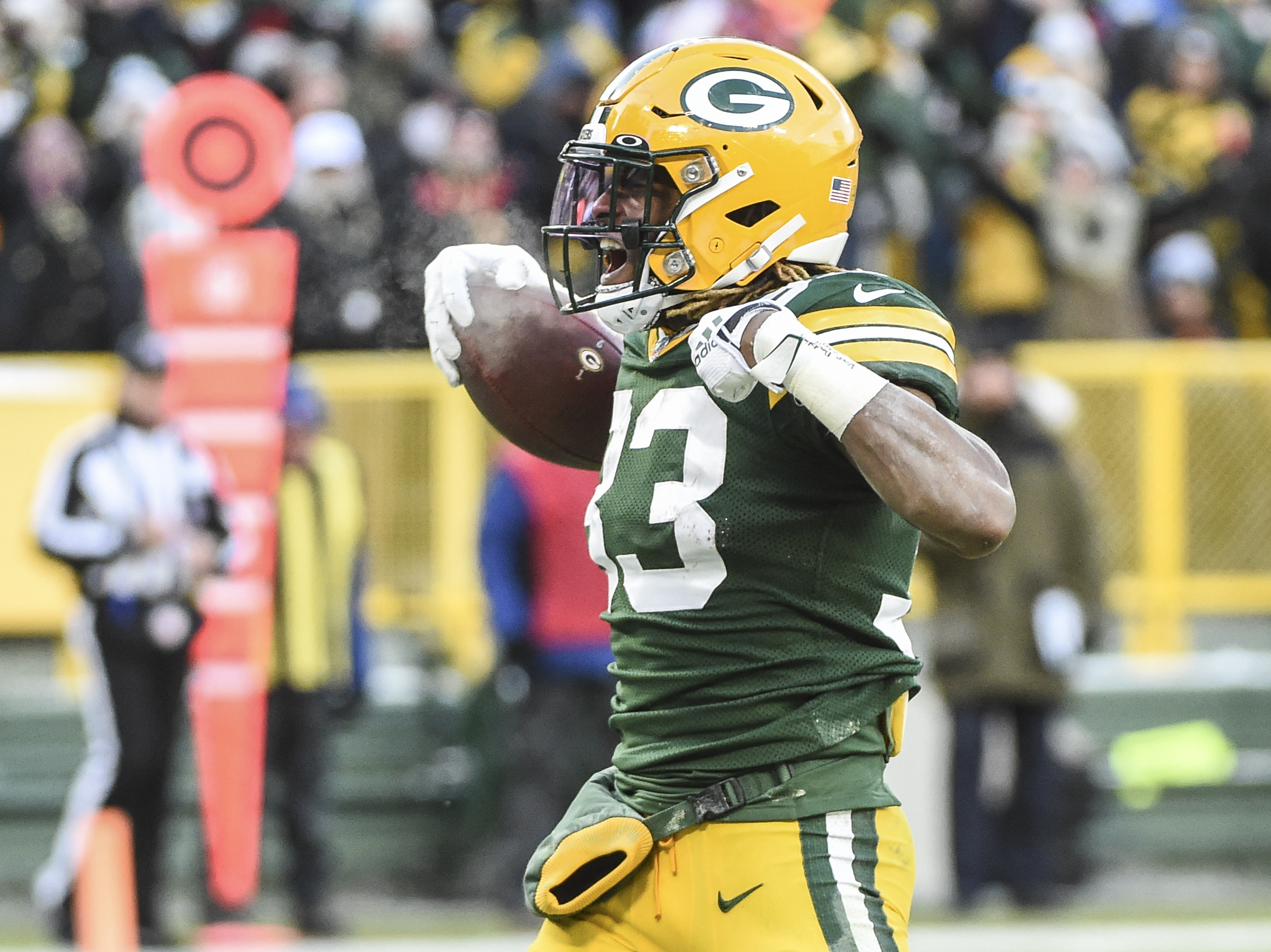
GREEN BAY PACKERS
- Eight of Aaron Jones’ 16 rushing touchdowns came from within the opponents’ 5-yard line. Targeting good offenses that often end up in the red zone or in goal-line situations is a surefire way to accumulate cheap touchdown points.
- Head coach Matt LaFleur’s offense ranked second in both deep pass attempts (93) and deep pass attempt percentage. It’s clear that both LaFleur and Aaron Rodgers prioritize the big play.
- During Weeks 6-17, wide receiver Allen Lazard ranked 12th in aDOT (14.2) among all receivers with 30-plus targets. With Devin Funchess opting out of the season, Lazard immediately becomes a highly intriguing second option for Rodgers and the Packers’ passing offense.
HOUSTON TEXANS
- Since Brandin Cooks entered the NFL in 2014, he ranks fourth in receiving yards (2,294) and fifth in touchdowns (17) on 20-plus yard throws. Health is an issue with Cooks, but he’s a walking explosive play when on the field and should fit in perfectly with Deshaun Watson.
- The Texans ranked 26th in pass attempts to running backs in 2019 with 77. Expect this number to increase with both David Johnson and Duke Johnson possessing dominant receiving ability.
- Dating back to 2015, Duke Johnson ranked third in targets, third in receptions, second in receiving yards, seventh in receiving touchdowns, first in missed tackles forced, first in explosive pass plays and ninth in yards per route run among all running backs with 150-plus targets. David Johnson ranked seventh in targets, 10th in receptions, fourth in receiving yards, second in touchdowns, fifth in missed tackles forced, second in explosive pass plays and eighth in yards per route run over the same time frame. This duo is second to none in terms of pass-catching ability for running backs.
INDIANAPOLIS COLTS
- The Colts ranked seventh in rushing yards before contact (652) and ninth in rushing yards before contact per attempt (1.4) in 2019. Both numbers bode well for rookie Jonathan Taylor and veteran Marlon Mack.
- The quarterback switch from Jacoby Brissett to Philip Rivers is a complete flip in terms of philosophy. Brissett ranked 26th in pass attempts 20-plus yards downfield (43), while Rivers ranked fourth with 79.
- The change from Brissett to Rivers should do wonders for both T.Y. Hilton and rookie Michael Pittman Jr. Dating back to 2012, only one player has more receiving yards or explosive pass plays than Hilton on 20-plus-yard targets. Pittman ranked 14th in college football in receiving yards on passes at least 20 yards downfield.
JACKSONVILLE JAGUARS
- The Jaguars registered the second-most snaps while trailing (723) in 2019. The consensus is that this team didn’t greatly improve and could ultimately have a repeat performance.
- Offensively, the Jaguars ranked third in 10 personnel percentage (8.1%) and ninth in 11 personnel percentage (67.9%). Theoretically speaking, this offense should be able to effectively sustain decent production from its top three wide receivers (see: D.J. Chark, Laviska Shenault, DeDe Westbrook, Chris Conley).
- Leonard Fournette ranked fourth in targets (95) among all running backs in 2019. It’s fair to expect Fournette’s receiving market share to be scaled back significantly due to the addition of pass-game specialist Chris Thompson as well as offensive coordinator Jay Gruden. Dating back to 2015, Thompson ranks 11th in targets among running backs (259).
KANSAS CITY CHIEFS
- No team ran more run-pass options (RPOs) than the Chiefs in 2019 — they deployed 197 RPOs.
- Clyde Edwards-Helaire excelled in creating yardage after contact in 2019, ranking 10th in missed tackles forced per rushing attempt (0.33) and 11th in missed tackles forced on receptions (11) among college running backs with at least 100 attempts.
- According to PFF’s fantasy projections, the Chiefs are the only team to field a player in the top 10 at quarterback (Patrick Mahomes), running back (Edwards-Helaire), wide receiver (Tyreek Hill), tight end (Travis Kelce) and defense.
LOS ANGELES RAMS
- As a team, Rams receivers ranked first in receiving yards after the catch (2,308). Robert Woods and Cooper Kupp both ranked highly in YAC with Woods coming in at second (580) and Kupp ranking fourth (548) among all wide receivers.
- Jared Goff offers zero rushing upside, but he’s still underrated as a fantasy option. Since head coach Sean McVay’s hiring in 2017, Goff has had finishes of QB12, QB6 and QB12 — he’s as safe of an option as there is at the position.
- The Rams have a lot of vacated touches entering the 2020 season. Todd Gurley’s departure opens 268 touches, and Brandin Cooks’ departure offers another 73 touches (67 targets). With both guys out of the picture, there's a lot of opportunity for the likes of Cam Akers, Josh Reynolds and Van Jefferson.
LOS ANGELES CHARGERS
- Wide receiver Mike Williams is the ultimate deep threat in today’s NFL — he ranked second in aDOT (18.8) and second in yards per reception (20.4) among receivers with 25-plus targets.
- From 2015-2017, Tyrod Taylor ranked second in rushing yards, rushing touchdowns and rushing yards after contact among all quarterbacks, in addition to ranking first in missed tackles forced.
- Austin Ekeler is arguably the best receiving back in football. His 2019 was truly dominant as a receiver — he ranked second in targets, receptions, yards, YAC and receiving yards after contact. He also ranked first in receiving touchdowns, explosive pass plays, receiving yards per reception and yards per route run.
LAS VEGAS RAIDERS
- Darren Waller was the only tight end to eclipse 85 targets yet score less than four touchdowns. Expect some positive regression for Waller, even with all the skill-position additions by the Raiders.
- Derek Carr is notoriously safe with the football, which can be both a positive and negative — he ranked 23rd in turnover-worthy plays among quarterbacks with 250-plus attempts. He also ranked second in adjusted completion percentage (82.3%).
- Rookie wide receiver Bryan Edwards ranked fifth in receptions behind the line of scrimmage (37) in 2019. Edwards made the most of such usage, ranking eighth in YAC per reception (10.5) and seventh in missed tackles forced (10) on passes behind the line.
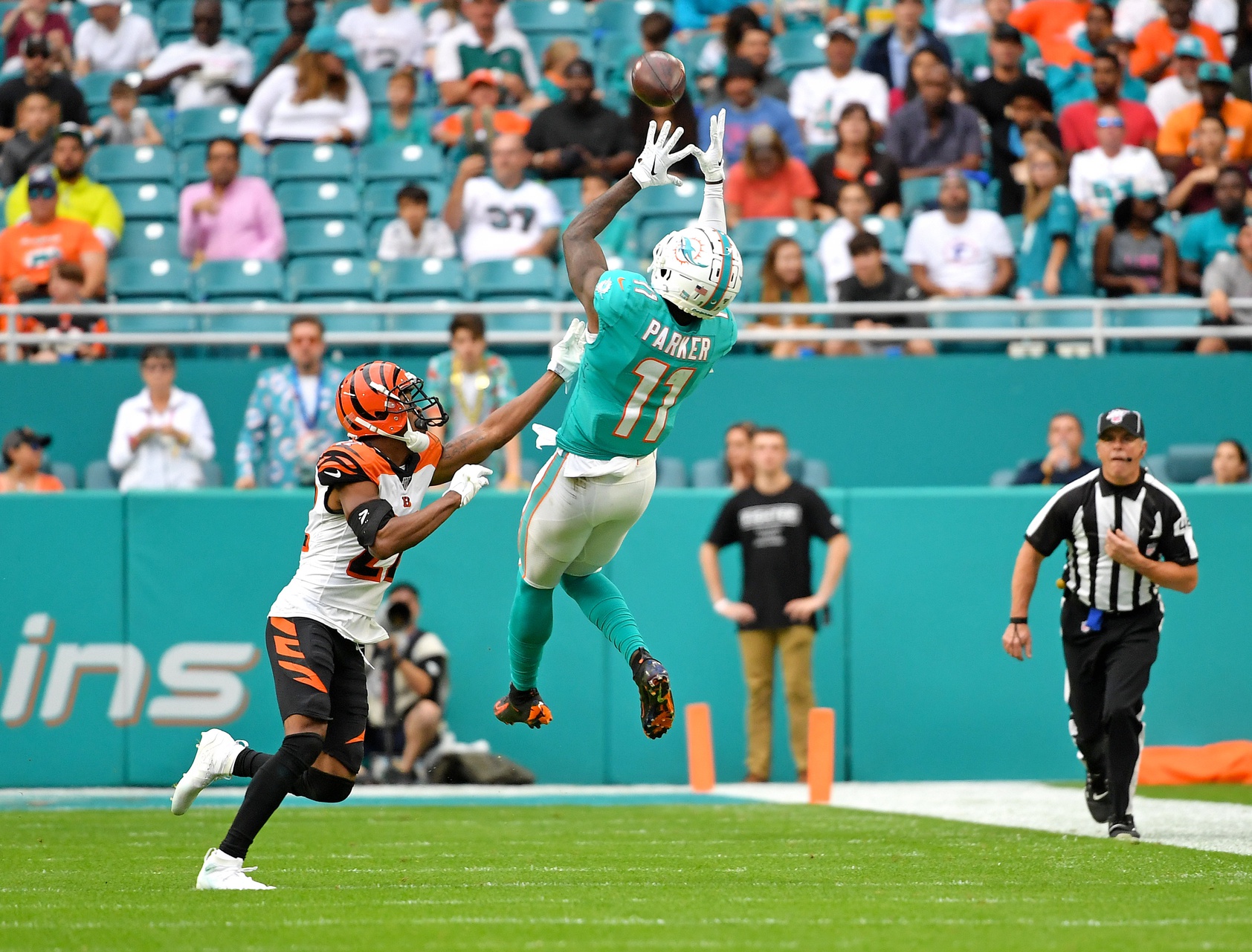
MIAMI DOLPHINS
- During Weeks 8-17, only one receiver was more productive than DeVante Parker and his 181.8 total points. Parker’s insane production coincided with Preston Williams’ season-ending injury in Week 7.
- The Dolphins were truly awful at rushing the football — the team ranked 32nd in rushing yards, rushing yards before contact and rushing yards after contact.
- Tight end Mike Gesicki took a big step forward in his development during Weeks 7-17. Gesicki ranked third in aDOT (11.36), eighth in fantasy points (118.8) and ninth in points per snap (0.22) among all tight ends.
MINNESOTA VIKINGS
- The Vikings deployed two-back sets at the fourth-highest rate in the league in 2019. New offensive coordinator Gary Kubiak oversaw offenses in Baltimore in 2014 and Denver in 2015 that deployed two-back sets the sixth- and seventh-most in the league, respectively.
- Rookie receiver Justin Jefferson was dominant in the slot in 2019 — he ranked ninth in targets, third in receiving yards, sixth in YAC, first in touchdowns and fourth in explosive pass plays out of the slot. Expect Jefferson to register a lot of snaps in the slot in 2020, with fellow wide receiver Adam Thielen kicking outside the numbers more frequently.
- Per PFF’s fantasy projections, Irv Smith Jr. is expected to overtake veteran Kyle Rudolph as the team’s most productive/targeted tight end — Smith projects as the TE20, while Rudolph projects as the TE22.
NEW ENGLAND PATRIOTS
- Cam Newton has a history of downright dominance in fantasy football. If his shoulder allows it, Newton is capable of recapturing some of his former magic. Newton’s schedule ranks as the second-easiest among quarterback schedules in 2020, per PFF’s SoS metric.
Cam Newton fantasy points per dropback finishes throughout his career:
2011: 2nd
2012: 3rd
2013: 4th
2014: 6th
2015: 1st
2016: 12th
2017: 2nd
2018: 7th
2019: N/AThis dude's shoulder could be cheddar cheese and he'd still land in the top-7 in 2020 somehow.
— Sosa K (@QBsMVP) June 29, 2020
- James White led all running backs in targets, receptions, receiving yards, touchdowns and first downs on third and fourth downs in 2019. White is an integral part of this offense in his role as a chain-mover.
- The Patriots ranked first in red-zone plays (189) and goal-line plays (54) in 2019. Even without Brady at the helm, this offense will offer plenty of opportunities for fantasy options by routinely visiting the most important part of the field.
NEW ORLEANS SAINTS
- The Saints and head coach Sean Payton deploy an incredibly quarterback-friendly offense — Drew Brees ranked first in adjusted completion percentage (82.9%) and Teddy Bridgewater ranked third (80.6%) among all quarterbacks with 150-plus attempts.
- Jared Cook proved to be a fantastic addition at tight end, as he ranked first in aDOT (11.44), fourth in yards per target (11.37) and second in yards per reception (16.40) among all tight ends.
- No quarterback is more daring than Saints backup QB Jameis Winston — he leads all quarterbacks in turnover worthy plays (144) since entering the league in 2015, and his total was 20 more than the next-highest total.
NEW YORK GIANTS
- Rookie quarterback Daniel Jones’ 18 fumbles last year was the fifth-highest total by any player in NFL history.
- The Giants ranked seventh in explosive run percentage (14.2%) in 2019. While they didn’t have the offensive success they wanted, Saquon Barkley proved to be one of the game’s most potent home run-hitting threats — he ranked fourth in 40-plus yard rushes (three) on the season and managed to do so in only 13 games.
- The fantasy world is sleeping on tight end Evan Engram. From weeks 1-9 (before injury), he ranked sixth in total points, eighth in points per snap, first in games with 100-plus yards, third in targets and fourth in red zone targets. The Giants would be wise to continue getting the ball to Engram, as he’s proven to be a major playmaker in his short NFL career.
NEW YORK JETS
- Le’Veon Bell was given no chance to succeed in 2019 — the Jets ranked 32nd in red zone plays and goal line plays, 31st in rushing yards before contact and 32nd in rushing yards before contact per attempt.
- Expect a strong season out of tight end Chris Herndon. His 2019 season was a wash due to a season-ending injury, but his 2018 campaign really displayed his intriguing skill set — he ranked seventh in explosive pass plays and aDOT and eighth in yards per route run among all tight ends that season.
- The Jets’ offense isn’t a powerhouse, but there is still value to be had — Jamison Crowder’s 118 targets ranked 15th and he scored the 26th-most fantasy points among all receivers in 2019.
PHILADELPHIA EAGLES
- The Eagles ranked first in their rate of 12 personnel (50.0%) last year, in part because of so many injuries at the wide receiver position. The next-closest team was the Minnesota Vikings at 34.9%. That's part of why the the duo of Zach Ertz and Dallas Goedert was so productive.
- From Weeks 14-17, Boston Scott (seventh) actually outscored Miles Sanders (eighth) in running back scoring.
- The Eagles ranked 10th in deep pass attempts. While that wasn’t a particularly low-frequency event, it’s fair to expect that number to increase with the additions of Jalen Reagor, DeSean Jackson, John Hightower and Quez Watkins.
PITTSBURGH STEELERS
- From 2017-2018, JuJu Smith-Schuster ranked second in YAC, seventh in touchdowns, 13th in explosive pass plays and 12th in yards per route run. His numbers suffered dramatically with Ben Roethlisberger out, but he's a prime bounce-back candidate heading into 2020.
- Conversely, Roethlisberger also proved to be wildly effective in his last healthy season — he ranked third in fantasy points and 13th in points per dropback in 2018.
- In 2018, Steelers’ weapons ranked fourth in yards after the catch per reception (6.2). Even with the injury issues and quarterback carousel, the team still ranked ninth in 2019 (5.8).
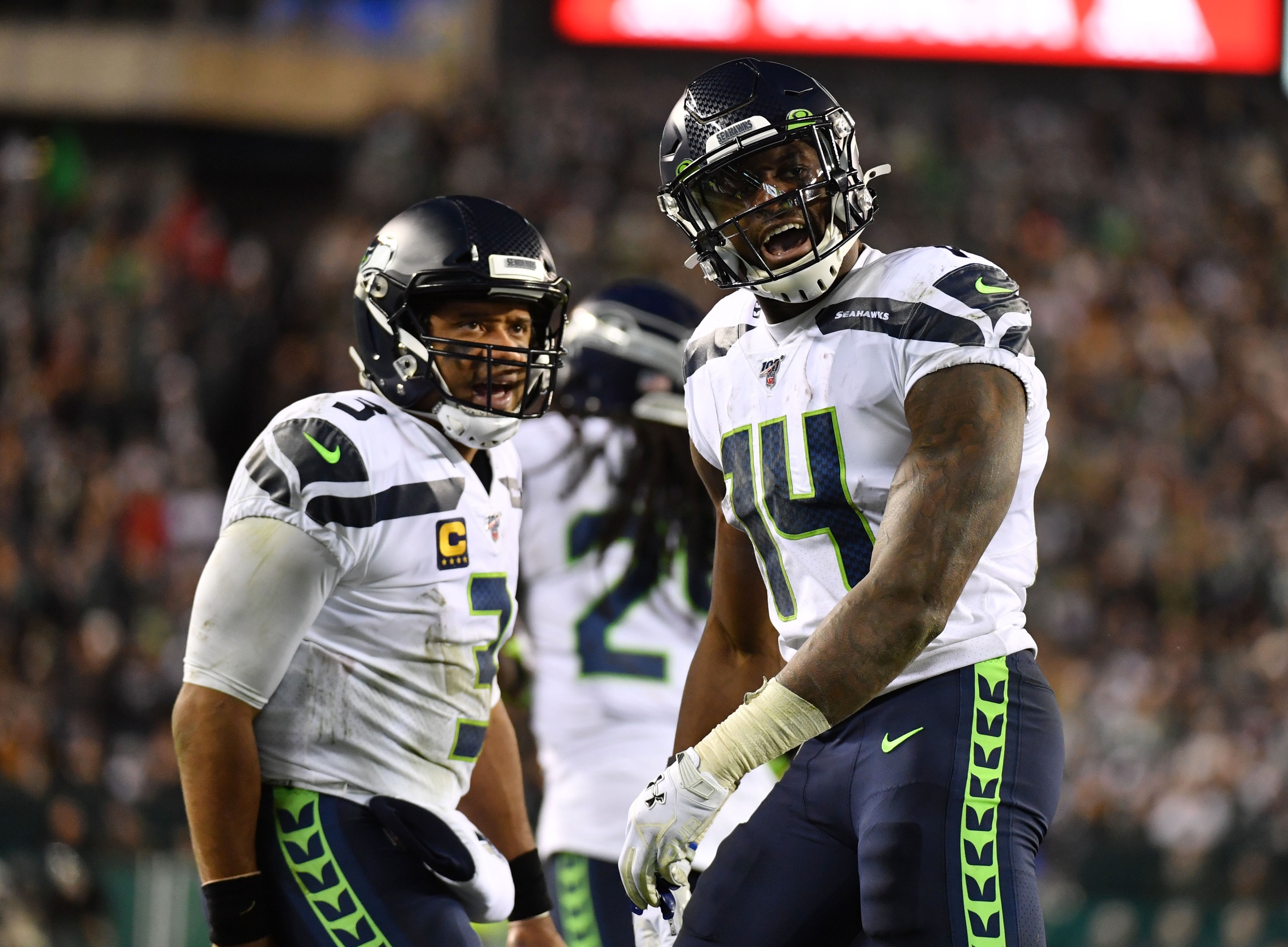
SEATTLE SEAHAWKS
- The Seahawks are hellbent on rushing the ball — they ranked seventh in run play percentage (41.6%) in 2019. This bodes well for Chris Carson and Rashaad Penny (once healthy).
- D.K. Metcalf’s 24 explosive pass plays in 2019 ranked 11th among all rookie receiver seasons dating back to 2010. He has proven to be a big-play threat and should continue to improve on that number if Russell Wilson provides him opportunities.
- One deep sleeper the Seahawks offer on their roster is tight end Will Dissly. During Weeks 1-6, Dissly ranked sixth in tight end scoring.
SAN FRANCISCO 49ERS
- No team lined up in 21 personnel more than the 49ers, as they deployed this personnel package 26.7% of the time. Because of their use of 21 personnel, the 49ers also ranked first in run plays versus eight-plus box defenders (302).
- Rookie first-round draft pick Brandon Aiyuk will bring even more yards after the catch ability to a roster that already possessed it in spades — he ranked third in YAC, first in receiving yards after contact and fifth in YAC per reception among all college receivers.
- The 49ers had a running back produce a top-10 finish in five weeks in 2019, four of which went to Raheem Mostert.
TAMPA BAY BUCCANEERS
- The Buccaneers ranked fourth in offensive plays per game (67.9), while the Patriots ranked third (68.4). Expect the Buccaneers to stay up-tempo with Tom Brady at the helm.
- Chris Godwin took a massive step forward into the elite tier of wide receivers last season — he ranked second in fantasy points and YAC and third in yards, missed tackles forced and explosive pass plays. And he managed all of this in only 14 games.
- The Buccaneers’ wide receiver schedule is ranked as the third-easiest in 2020, according to PFF’s SoS metric. This bodes well for Godwin, Mike Evans and potentially even rookie Tyler Johnson.
TENNESSEE TITANS
- Rookie receiver A.J. Brown’s 2019 season was truly one for the books — he ranked fifth in points per snap, second in points per touch, second in yards per target, third in yards per reception and second in YAC per reception. While his efficiency numbers are likely to go down in 2019, his volume should increase — draft Brown with comfort in 2020.
- Derrick Henry’s lack of pass-game usage (23 targets) is always a concern for his volume, and it could present a role for rookie running back Darrynton Evans in 2020. Former backup running back Dion Lewis registered 30 targets in 2019.
- The Titans ranked third in explosive pass percentage (17.4%) last season. Ryan Tannehill might not be able to duplicate last year's numbers, but he proved more than capable of supporting multiple fantasy-relevant skill players.
WASHINGTON FOOTBALL TEAM
- Like A.J. Brown, Terry McLaurin absolutely dominated in 2019 — he ranked 10th in yards per route run (2.05) among all rookie receiver seasons dating back to 2010.
- The sample size is obviously very small, but Derrius Guice last year flashed the skills that made him such an early draft pick two years ago. His 5.1 yards after contact per attempt ranked first among all running backs in the NFL with 25-plus rushing attempts. Guice could prove to be a steal this season if his health permits it.
- Washington’s 613 snaps run while trailing ranked seventh in the NFL in 2019. The team doesn’t appear to be greatly improved and could ultimately offer more garbage time production this season.
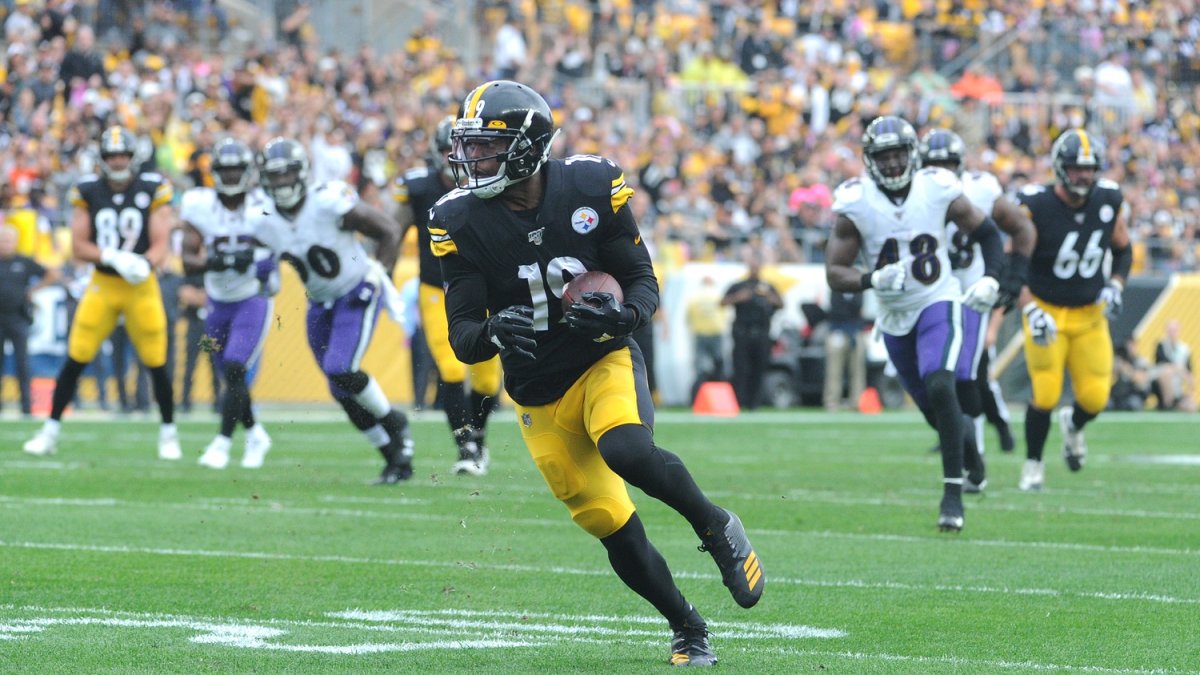


 © 2025 PFF - all rights reserved.
© 2025 PFF - all rights reserved.